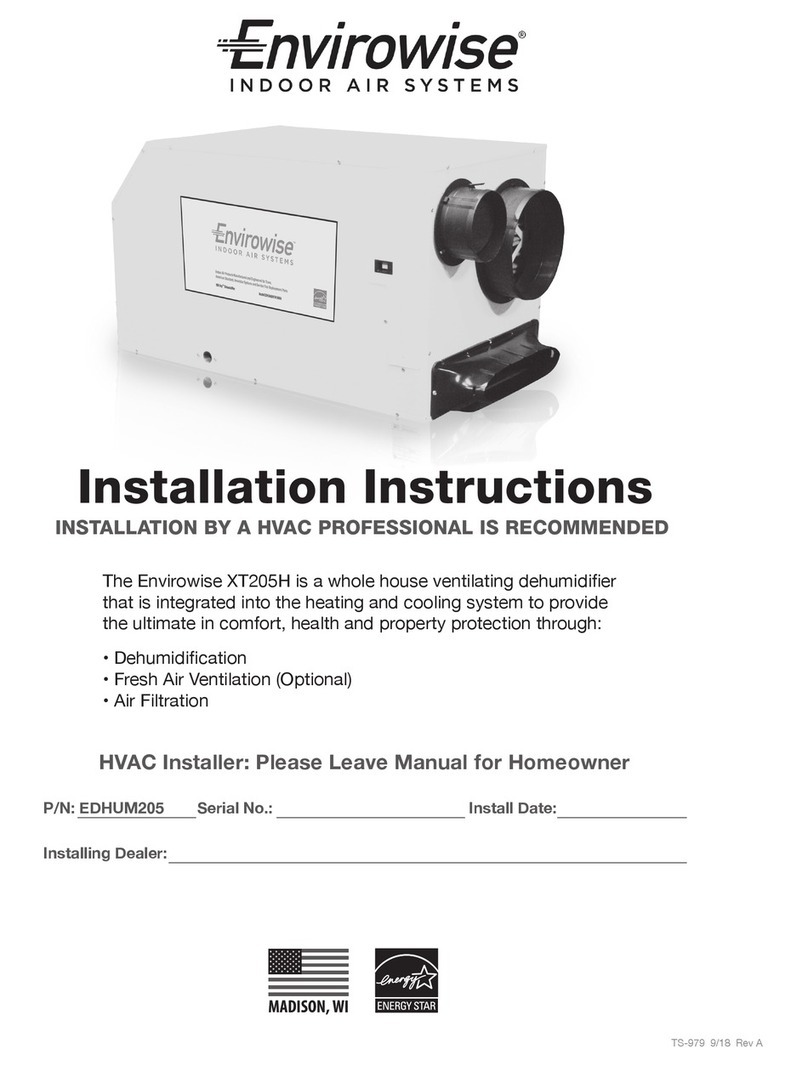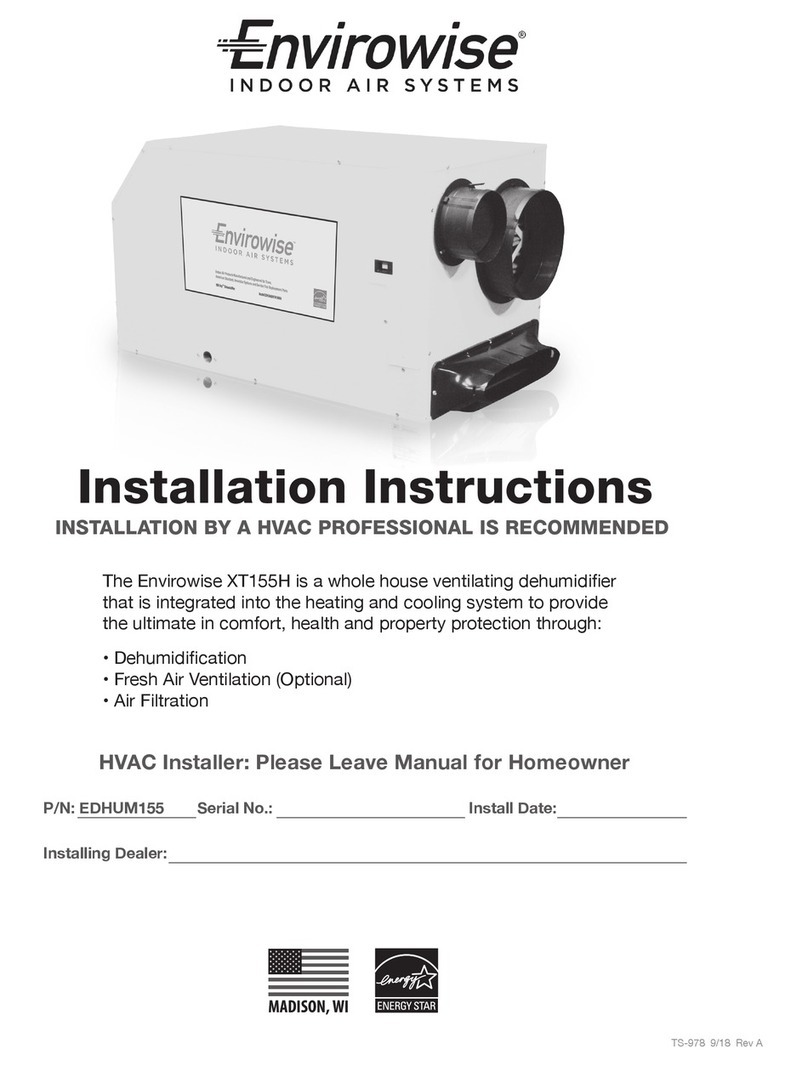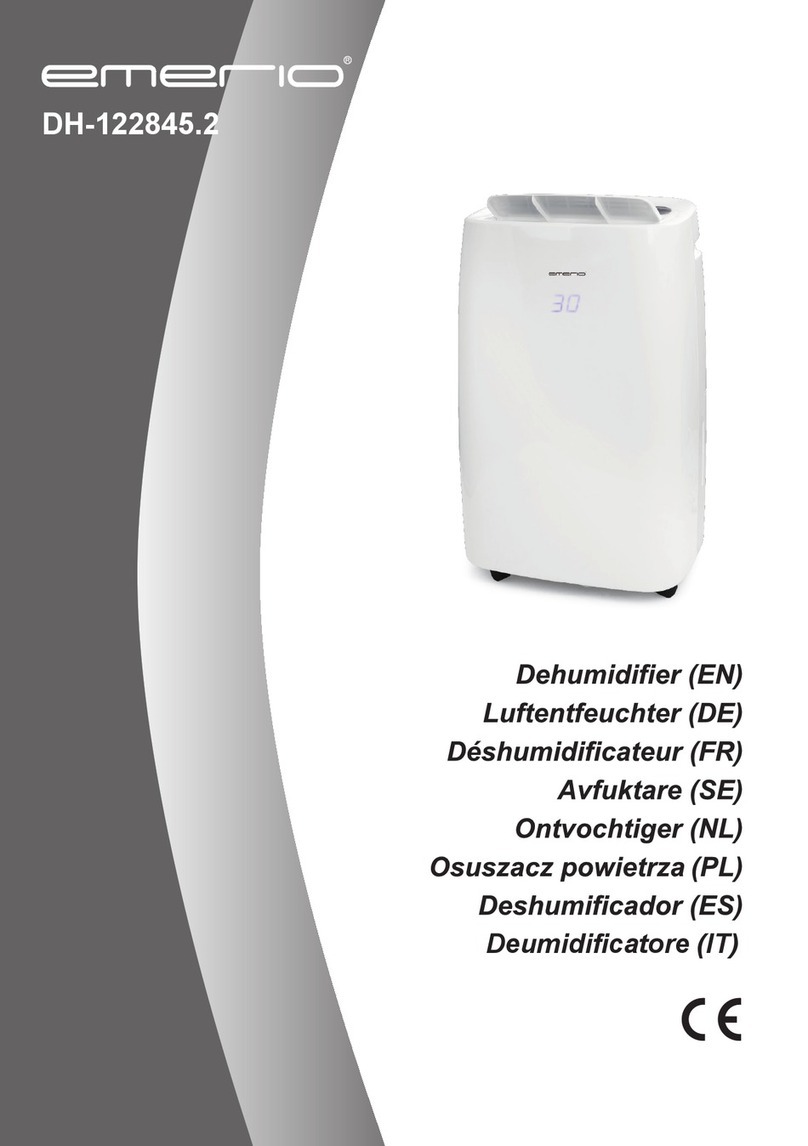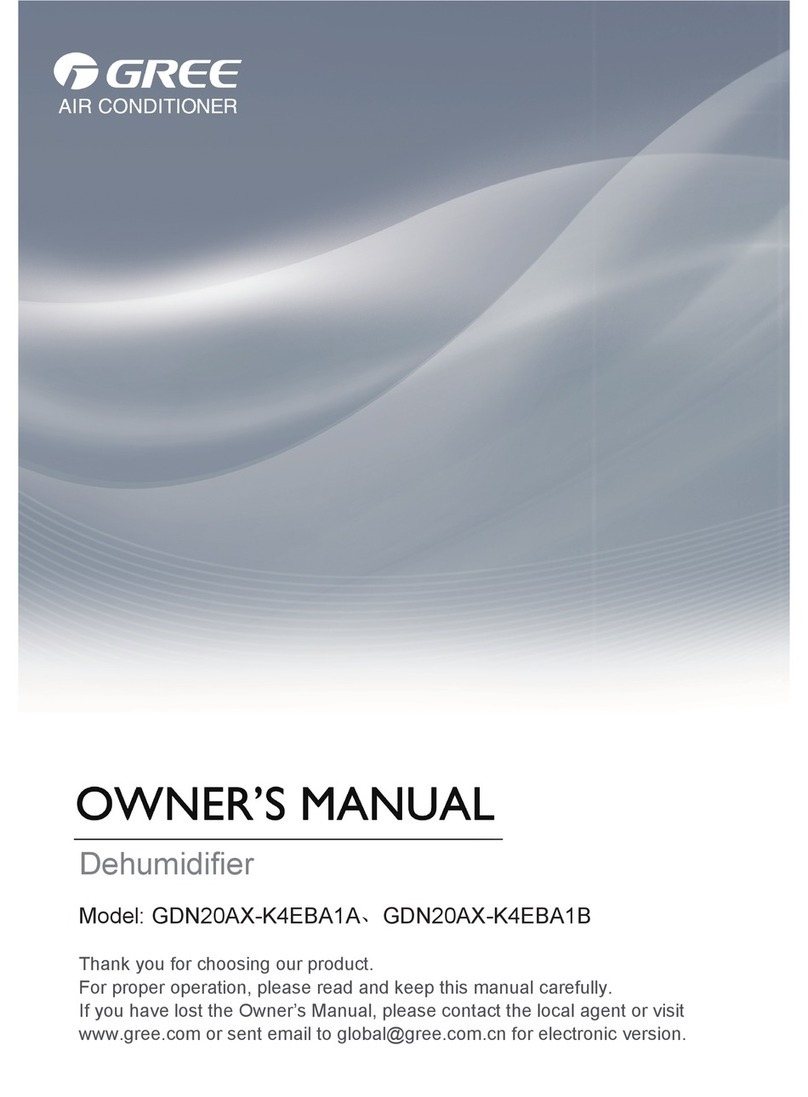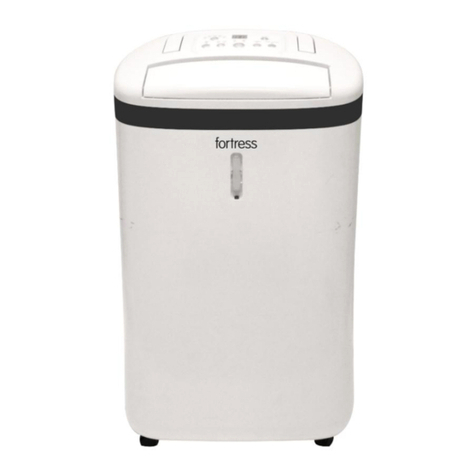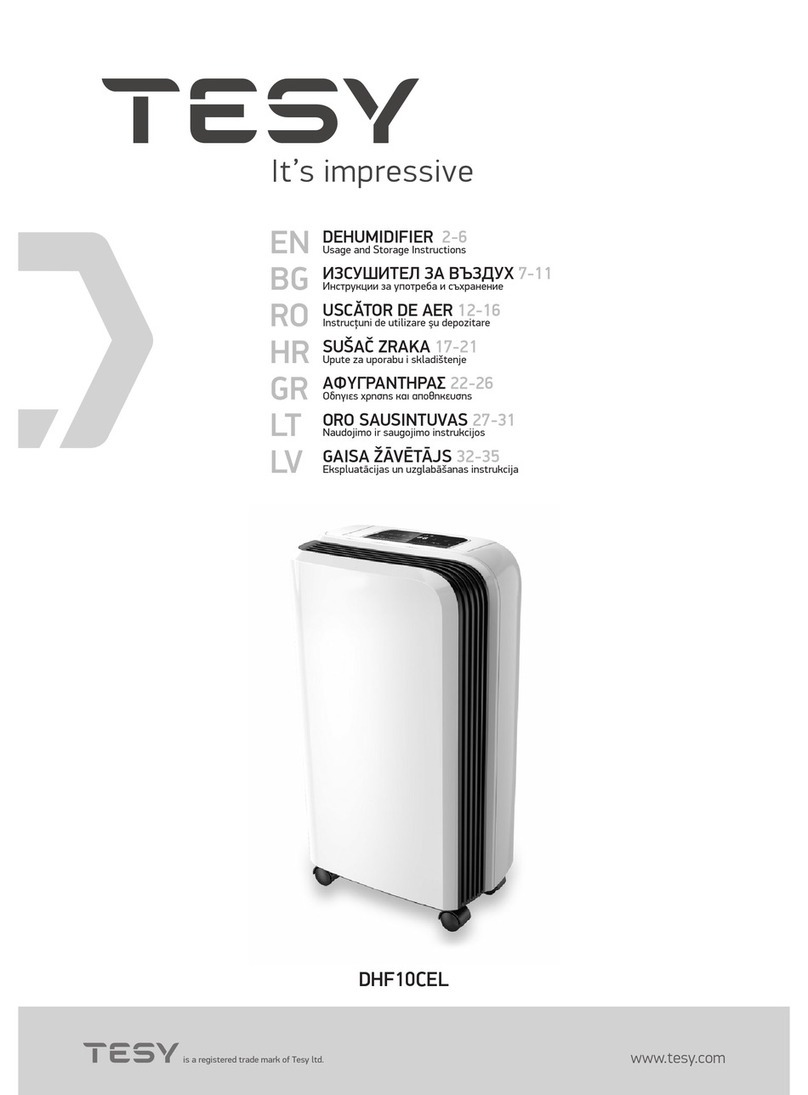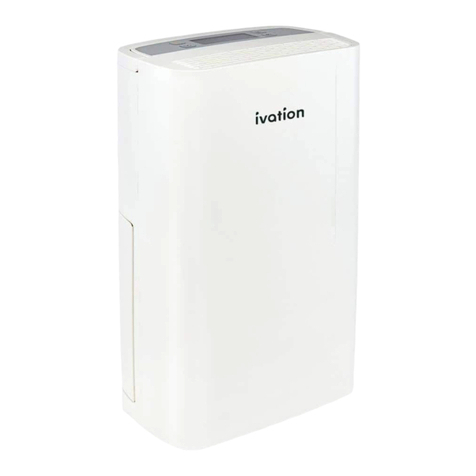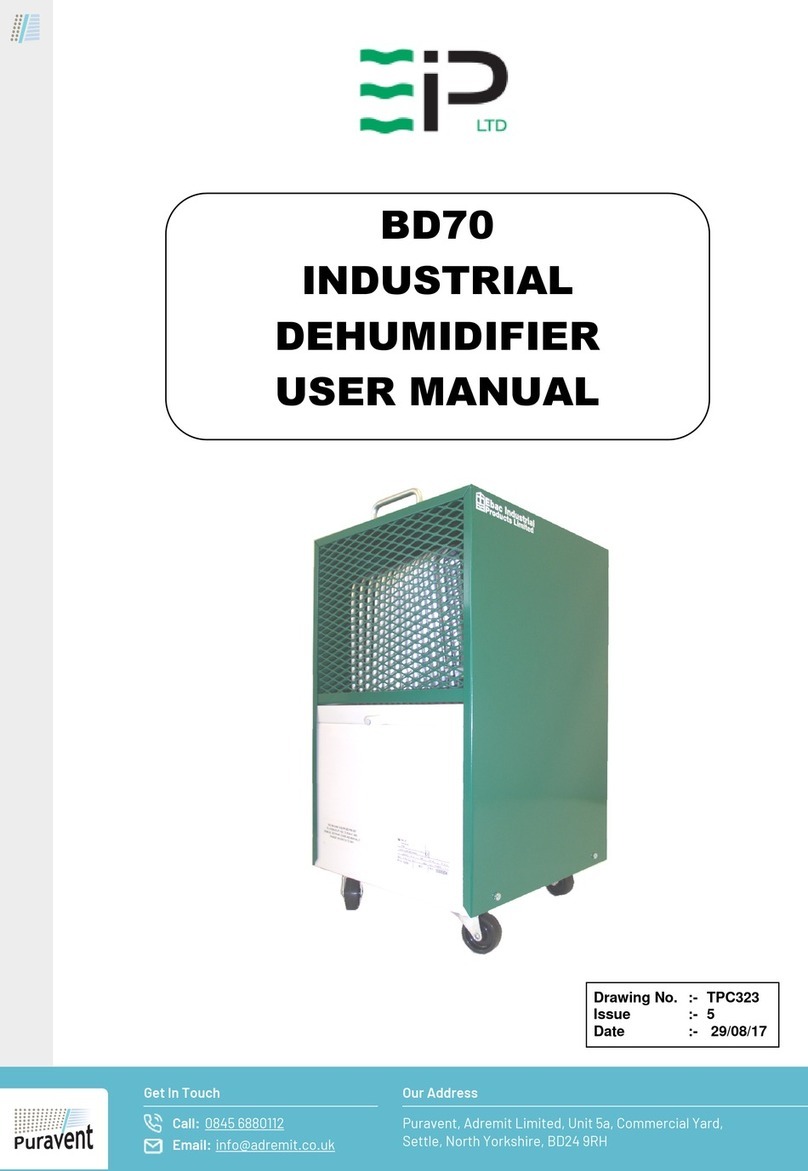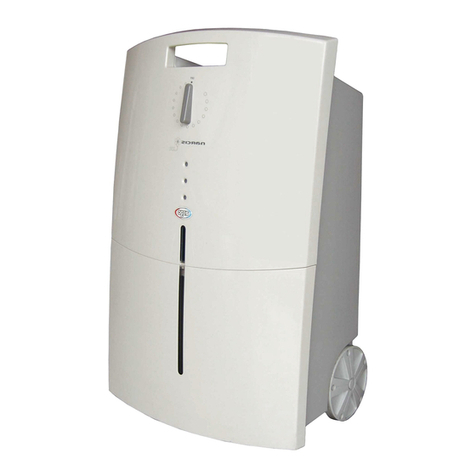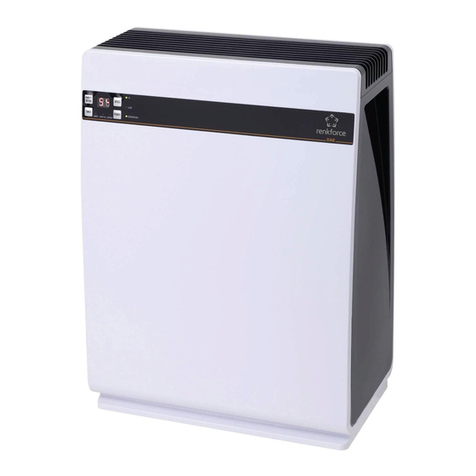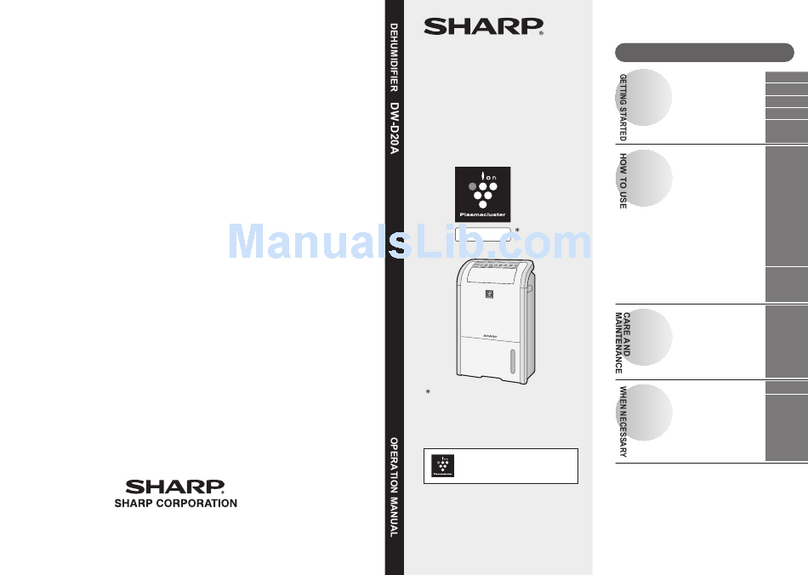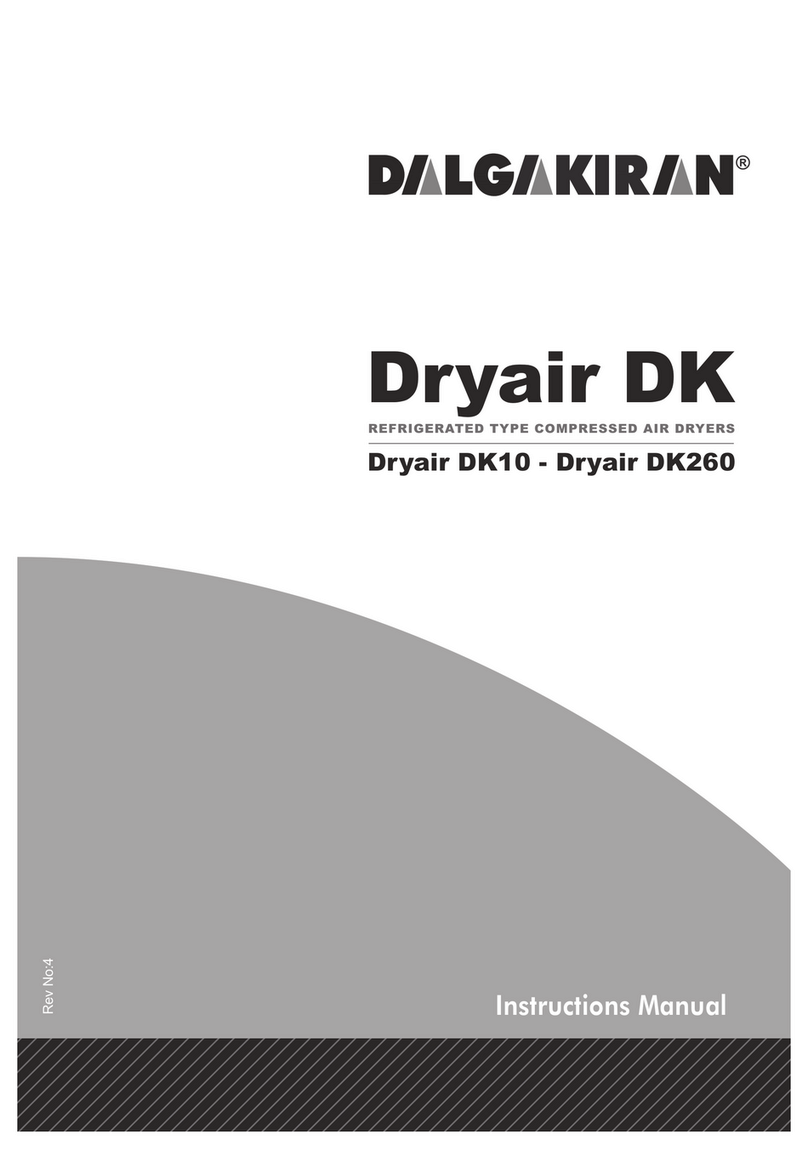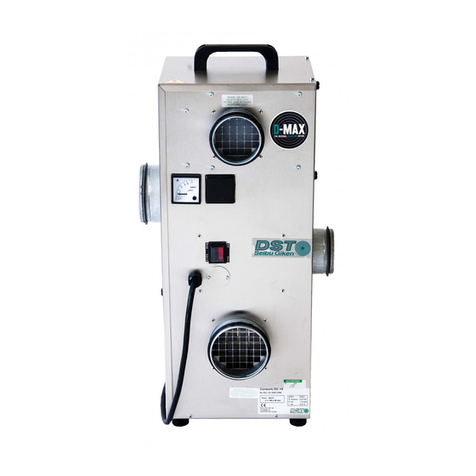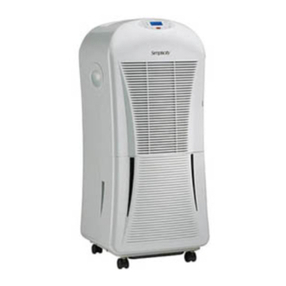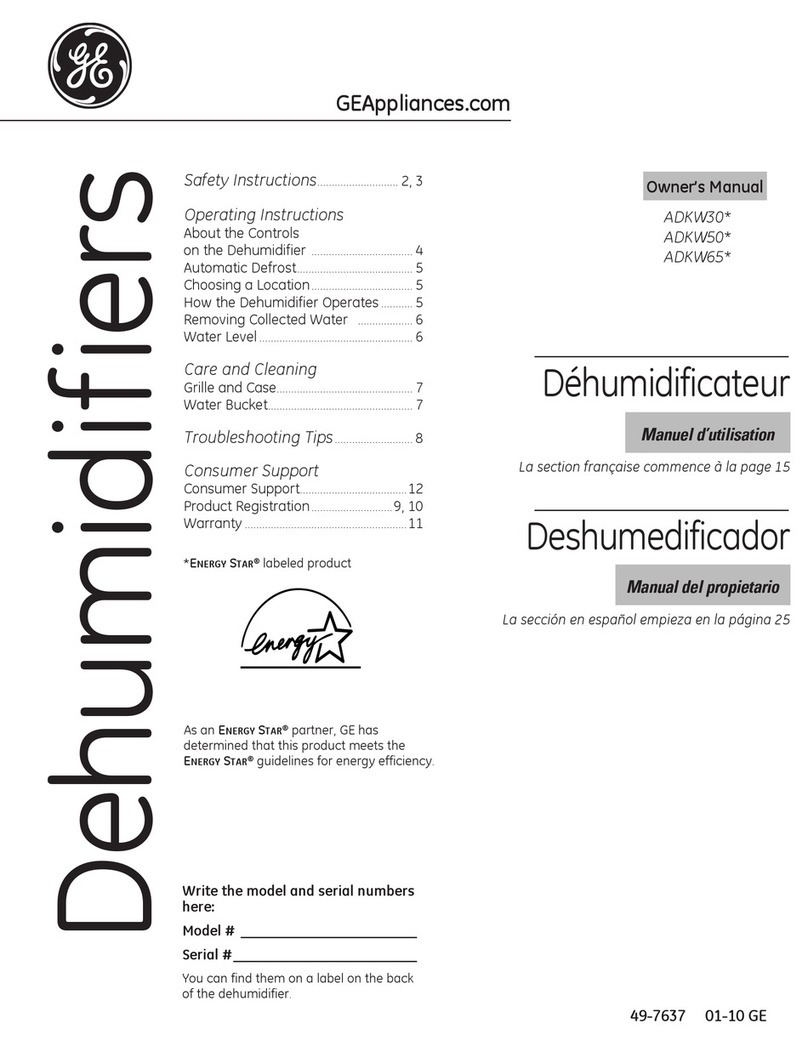Envirowise SD12 User manual

The Envirowise SD12 is a split system dehumidier with sensible cooling
that is integrated into the heating and cooling system to provide the
ultimate in comfort and property protection through:
• Dehumidication
• Sensible Cooling
• Fresh Air Ventilation (Optional)
• Air Filtration
The two-piece design allows the sensible heat load generated from
dehumidifying the house to be released in the outside condensing unit,
thus eliminating additional cooling requirements.
TS-980 5/19 Rev A
P/N: EDHUMS12 Serial No.: Install Date:
Installing Dealer:
HVAC Installer: Please Leave Manual for Homeowner
Installation Instructions
INSTALLATION BY A HVAC PROFESSIONAL IS RECOMMENDED

Safety Instructions ...................................................................... 3
Specifications .............................................................................. 4
General Set Up ............................................................................ 5
Attaching Duct Collars................................................................. 7
Electrical Requirements .............................................................. 8
Line Set Installation................................................................... 11
Drain Installation ....................................................................... 18
Ducting to HVAC Systems.......................................................... 19
Recommended HVAC System Installations ........................................ 20
No Existing Ductwork Installation ....................................................... 21
Fresh Air Ventilation .................................................................. 22
Determine Ventilation Requirements ................................................... 23
Controls ..................................................................................... 24
Filter Instructions ...................................................................... 27
Optional Accessories................................................................. 28
Service....................................................................................... 29
Troubleshooting................................................................................... 29
TABLE OF CONTENTS
Ingersoll Rand is committed to manufacturing quality products. To maintain
our standards, product specications may change without notice.
Ingersoll Rand, 6200 Troup Hwy. Tyler, TX 75707
Items Included in Box:
• Envirowise SD12 Dehumidier
• Envirowise SD12 Condensing Unit
• Envirowise SD12 Installation Instructions
• Envirowise SD12 Leveling Feet

3
Envirowise SD12 Installation Instructions
SAFETY INSTRUCTIONS
WARNING!
THIS SYMBOL MEANS IMPORTANT INSTRUCTIONS. FAILURE TO HEED THEM
CAN RESULT IN SERIOUS INJURY OR DEATH.
READ THE INSTALLATION, OPERATION AND MAINTENANCE INSTRUCTIONS CAREFULLY
BEFORE INSTALLING AND OPERATING THIS DEVICE. PROPER ADHERENCE TO
THESE INSTRUCTIONS IS ESSENTIAL TO OBTAIN MAXIMUM BENEFIT FROM YOUR
ENVIROWISE WHOLE HOUSE VENTILATING DEHUMIDIFIER.
CAUTION!
THIS SYMBOL MEANS IMPORTANT INSTRUCTIONS. FAILURE TO HEED THEM
CAN RESULT IN INJURY OR MATERIAL PROPERTY DAMAGE.
Registrations
The Envirowise SD12 conforms to unied standard UL 474 and CSA Standard C22.2 No. 92.
CAUTION!
READ ALL INSTRUCTIONS BEFORE BEGINNING INSTALLATION.
ALWAYS USE CAUTION AND WEAR CUT RESISTANT GLOVES WHEN HANDLING SHEET METAL.
IMPROPER INSTALLATION MAY CAUSE PROPERTY DAMAGE OR INJURY. INSTALLATION, SERVICE,
AND MAINTENANCE MUST BE PERFORMED BY A QUALIFIED SERVICE
TECHNICIAN.
DEHUMIDIFIER IS HEAVY. HANDLE WITH CARE AND FOLLOW INSTALLATION INSTRUCTIONS.
DO NOT USE IN POOL APPLICATIONS, OR WARRANTY WILL BE VOID.
NEVER OPERATE A UNIT WITH A DAMAGED POWER CORD. IF THE POWER CORD IS DAMAGED, IT
MUST BE REPLACED BY THE MANUFACTURER, ITS SERVICE AGENT, OR A SIMILARLY QUALIFIED
PERSON IN ORDER TO AVOID A HAZARD.
THIS APPLIANCE IS NOT INTENDED FOR USE BY PERSONS (INCLUDING CHILDREN) WITH REDUCED
PHYSICAL, SENSORY OR MENTAL CAPABILITIES, OR LACK OF EXPERIENCE OR KNOWLEDGE,
UNLESS THEY HAVE BEEN GIVEN SUPERVISION OR INSTRUCTION CONCERNING THE USE OF THE
APPLIANCE BY A PERSON RESPONSIBLE FOR THEIR SAFETY. CHILDREN SHOULD BE SUPERVISED
TO ENSURE THAT THEY DO NOT PLAY WITH THE APPLIANCE.
THE CLEAN AIR ACT OF 1990 BANS THE INTENTIONAL VENTING OF REFRIGERANT (CFCs, HCFCs, AND
HFCs) AS OF JULY 1, 1992. APPROVED METHODS OF RECOVERY, RECYCLING OR RECLAIMING MUST
BE FOLLOWED. FINES AND/OR INCARCERATION MAY BE LEVIED FOR NONCOMPLIANCE.
WARNING!
120 VOLTS MAY CAUSE SERIOUS INJURY FROM ELECTRIC SHOCK. DISCONNECT ELECTRICAL
POWER BEFORE STARTING INSTALLATION OR SERVICING, AND LEAVE POWER DISCONNECTED
UNTIL INSTALLATION OR SERVICE IS COMPLETED.
IMPROPER INSTALLATION MAY CAUSE PROPERTY DAMAGE OR INJURY. INSTALLATION, SERVICE,
AND MAINTENANCE MUST BE PERFORMED BY A QUALIFIED SERVICE TECHNICIAN.

4Envirowise SD12 Installation Instructions
SPECIFICATIONS
SIDE VIEW FRONT VIEW
33”
25 1/2”
25 1/2”
10”
Dehumidifier
Part Number: EDHUMS121S1MDA
Blower: 406 CFM @ 0.0" WG
374 CFM @ 0.2" WG
348 CFM @ 0.4" WG
Power: 160 Watts @ 80°F and 60% RH
Supply Voltage: 115 VAC – 1phase – 60 Hz
Current Draw: 1.4 Amps
Transformer Protection: Push Button Reset (located near power cord)
Circuit Requirement: 15 Amps, Dedicated
Energy Factor: 3.1 L/kWh
Operating Range: 49°F Min, 95°F Max (Inlet Air Temperature)
Sized For: Up to 4,000 Square Feet
Minimum Performance at: 80°F and 60% RH 70°F and 60% RH
Water Removal: 184 Pints/Day 150 Pints/Day
Sensible Cooling: 4,300 BTUs/Hour 5,100 BTUs/Hour
Eciency: 6.6 Pints/kWh 6.0 Pints/kWh
Duct Connections: 6" Round Inlet; 10" Round Inlet; 10" Oval Outlet
Air Filter: MERV-11, Standard Pleat
Eciency: 65% ASHRAE®Dust Spot
Size: 16"x 20"x 2"
Power Cord: 9', 115 VAC, Ground
Internal Insulated Cabinet: Yes
Drain Connection: 3/4" Threaded Female NPT
Line Set Requirements: 50 Feet (maximum)
Liquid Line: 1/4"
Gas Line: 3/8"
Dimensions: Unit With Collars Unit Without Collars Shipping
Width: 20 1/4" 20 1/4" 35"
Height: 21 3/4" 21 3/4" 44"
Length: 41 1/2" 37 3/4" 44"
Weight: 110 lbs. 109 lbs. 225 lbs.
Condenser
Part Number: E4037626
Power: 1080 Watts @ 80°F and 60% RH
Supply Voltage: 115 VAC – 1phase – 60 Hz
Current Draw: 9.7 Amps
Minimum Circuit Ampacity: 20 Amps, Dedicated
Maximum Fuse / Breaker: 20 Amps
Refrigerant Type: R410A
Refrigerant Amount: 36 oz.
Operating Range: 40°F Min, 115°F Max
Dimensions: 10”W x 25.5”H x 33”L - 75 lbs.
Power Cord: Hard-Wired
FRONT VIEW
20 1/4”
21 3/4”
21 3/4”
41 1/2”
37 3/4”
21 3/4”
21 3/4”
BACK VIEW
20 1/4”
SIDE VIEW
FRONT VIEW
20 1/4”
21 3/4”
21 3/4”
41 1/2”
37 3/4”
21 3/4”
21 3/4”
BACK VIEW
20 1/4”
SIDE VIEW
FRONT VIEW
20 1/4”
21 3/4”
21 3/4”
41 1/2”
37 3/4”
21 3/4”
21 3/4”
BACK VIEW
20 1/4”
SIDE VIEW

5
Envirowise SD12 Installation Instructions
GENERAL SET UP
Important Precautions
• The dehumidier is designed to be installed indoors in a space that is protected from rain and ooding.
• Install the dehumidier with enough space to access the back and side panels for maintenance and service.
• Avoid directing the discharge air at people.
• If used near a water source, be certain there is no chance the dehumidier could fall into the water or get
splashed and that it is plugged into a dedicated circuit and Ground Fault Circuit Interrupter (GFCI) protected
outlet.
• DO NOT use the dehumidier as a bench or table.
• DO NOT place the dehumidier directly on structural building members without vibration absorbers or unwanted
noise may result. Place the dehumidier on supports to raise the base of the unit.
• A drain pan with a oat switch MUST be placed under the dehumidier if installed above a living area or above
an area where water leakage could cause damage.
Location Considerations
• Avoid using the dehumidier in stand-alone crawl space or basement applications. The cool air in the crawl
space or basement, along with the cool air produced by the dehumidier, will have a negative eect on the
performance of the machine and cause the system to fall into a defrost cycle.
• Allow sucient clearance to handle the unit’s overall dimensions as well as the necessary return and supply
ductwork to the unit.
• Allow sucient clearance for lter removal and to prevent airow obstruction.
• Electrical service access will require the removal of a side panel. Allow sucient clearance on a side of the unit.
• Locate the dehumidier in an area where the cord’s length (9') easily reaches a 115 VAC electrical outlet with a
minimum of a 15 Amp dedicated
circuit capacity.
• Locate the dehumidier in an area
where eld wiring the control (low
voltage) to the unit will be possible.
• It is recommended that a backdraft
damper be used in the discharge
duct of the dehumidier, especially
when connecting to the supply
ducting system. The backdraft
damper prevents supply air from
counter owing through the
dehumidier when it is not
operating. The dehumidier’s
location should be chosen to
allow installation of this accessory
if necessary.
• The dehumidier may be suspended
from structural members with steel
hanger straps or a suitable
alternative, ensuring the assembly
supports the dehumidier’s base
in its entirety. DO NOT hang the
dehumidier from its cabinet.
• Allow for proper routing and drainage
of needed drain pipes.
Electrical Service Access
(Either Side)
Filter 9' Power Cord
Top View
Minimum
Clearance
For Filter
(Either Side)
15"
6" Fresh Air Intake (Optional)
10" Return Air Duct
10" Supply Air Duct
A
B
C
32 3/8"
With Collars Installed
26"
Without Collars Installed
B
C
Drain Port
A
Top View
41 1/2"
With Collars Installed
37 3/4"
Without Collars Installed
Drain Port 9' Power CordFilter
Minimum
Clearance
For Filter
(Either Side)
20"
6" Fresh Air Intake (Optional)
10" Return Air Duct
A
B
6” Fresh Air
Intake (Optional)
10” Return Air Duct
Electrical Service Access
(Either Side)
A
B
The 10” Supply Air Duct (not pictured) is
below the Fresh Air Intake and the Return
Air Duct. The same amount of clearance
is needed for the 10” Supply Air Duct.

6Envirowise SD12 Installation Instructions
GENERAL SET UP
Important Precautions
• The condensing unit is designed to be installed outdoors in a space that is protected from extreme
weather (rain, wind, etc.). Do not place the condensing unit in direct sunlight.
• Place the condensing unit at least 1” above ground level.
• Place the condensing unit as close as possible to the dehumidier to minimize the length of the
connecting lines. The maximum line set length is 50 feet.
• Ensure the mounting of the condensing unit can withstand strong winds and earthquakes when mounting
above ground level.
• The condensing unit may be mounted to a wall (with brackets) or placed on a roof.
• Mount the base of the condensing unit to a sturdy level pad (or bracket) using 3/8” (10mm) bolts.
• Avoid directing the discharge air at people.
• If used near a water source, be certain there is no chance the condensing unit could fall into the water or
get splashed and that it is plugged into a dedicated circuit and Ground Fault Circuit Interrupter (GFCI)
protected outlet.
• DO NOT use the condensing unit as a
bench or table.
• DO NOT place the condensing unit
where the sound and vibration caused
by running the unit will a cause a
nuisance. Vibration dampening material
may be installed between the condensing
unit base and the mounting pad if required.
Location Considerations
• Allow sucient clearance to handle the
unit’s overall dimensions.
• Place the condensing unit where there is
adequate space for the unit and the air
required by the unit.
• Install the condensing unit with space
to access the top and side panels for
maintenance and service.
CAUTION!
THIS SYSTEM CONTAINS BOTH REFRIGERANT AND OIL. SOME RUBBER ROOFING
MATERIAL MAY ABSORB OIL AND CAUSE THE RUBBER TO SWELL WHEN IT COMES
INTO CONTACT WITH OIL. THE RUBBER WILL THEN BUBBLE AND COULD CAUSE LEAKS.
PROTECT THE ROOF SURFACE TO AVOID EXPOSURE TO REFRIGERANT AND OIL DURING
SERVICE AND INSTALLATION. FAILURE TO FOLLOW THIS NOTICE COULD RESULT IN
DAMAGE TO ROOF SURFACE.
MIN
5.88"
MIN
7.88"
MIN
23.63"
MIN
9.88"
10.06"
5.62" 19.69" 5.62"
Minimum Distance Required for Condensing Unit
and The Footing Dimensions

7
Envirowise SD12 Installation Instructions
ATTACHING DUCT COLLARS
Duct Collar Installation
Remove the two round ducts, oval duct, and oval duct seal and small bag of mounting hardware from inside
the rectangle opening.
Fresh Air Ventilation Duct
Fresh air ventilation is optional. Attach 6" diameter duct to the unit using the screws provided. The 6" duct
should be capped if fresh air is not desired. If setting up the unit to provide fresh air ventilation, see page 24.
Return Air Inlet
Attach 10" diameter duct collar to the unit with the screws provided.
Supply Air Outlet
Adhere seal onto the back of the oval duct and mount the duct to the front of the dehumidier using the screws
provided.
Collars and
hardware are
located here.
SIDE VIEW
FRONT VIEW
6" Fresh Air Inlet (Optional)
10" Return Air Inlet
10" Supply Air Outlet
A
B
C
A
B
C

8Envirowise SD12 Installation Instructions
GENERAL SET UP
Electrical Requirements
The dehumidier plugs into a dedicated grounded 115 VAC outlet. The device draws 1.4 Amps at
80°F and 60% RH and can be plugged into a shared branch circuit. Locate the dehumidier in an area
where the cord’s length (9') easily reaches a 115 VAC electrical outlet. If used in an area that may become
wet, a GFCI protected circuit is recommended. Consult local electrical codes for further information. Field
wiring must comply with the National Electric Code (C.E.C. in Canada) and any applicable local codes or
ordinances.
Envirowise oers a variety of control devices for use with the Envirowise SD12. The control is to be located
remotely from the dehumidier and placed in the space to be conditioned. A low voltage (24 Volt) control MUST
be used with the Envirowise SD12 and MUST be connected with low voltage (18-22 gauge) thermostat wire.
Electrical Precautions
• Do not install the control where it may not accurately
sense the relative humidity such as near HVAC supply
registers, near exterior doors, on an outside wall, near
a window, or near a water source.
• The screw terminals on the Envirowise SD12 and the
control are labeled to prevent confusion.
• Be sure to consult the electrical schematic in the
CONTROLS Section (page 24) of this manual or
inside the access panel of the dehumidier before
making control connections.
WARNING!
THE REMOTE CONTROLS OF THE ENVIROWISE SD12 ARE POWERED BY A LOW VOLTAGE CIR-
CUIT (24 VAC) AND MUST NEVER CONTACT OR BE CONNECTED TO A HIGH VOLTAGE CIRCUIT.
Dehumidier Wiring Diagram
WARNING!
ELECTRIC SHOCK HAZARD. CAN CAUSE INJURY OR DEATH. UNIT MUST BE GROUNDED IN AC-
CORDANCE WITH NATIONAL AND LOCAL CODES. DISCONNECT ALL REMOTE ELECTRIC POWER
SUPPLIES BEFORE OPENING ACCESS PANEL. UNIT MAY HAVE MULTIPLE POWER SUPPLIES.
CAUTION!
DO NOT ALLOW THE 24V TERMINAL TO CONTACT THE COM TERMINAL ON THE
ENVIROWISE SD12 OR DAMAGE TO THE TRANSFORMER WILL RESULT.
CAUTION!
SOME OF THE SCREW TERMINALS ON
THE ENVIROWISE SD12 MAY NOT BE USED
WITH CERTAIN CONTROLS AND SHOULD
BE LEFT UNCONNECTED.

9
Envirowise SD12 Installation Instructions
The condensing unit requires a dedicated 120 VAC 20 Amp circuit capacity. Install a properly sized branch
circuit disconnect (20 Amp) within sight of the unit. The installer must supply the power wiring for the
condensing unit. The power wiring must have a Minimum Circuit Ampacity of 20A and be run within a
rain-tight conduit. The condensing unit must be grounded as required by applicable code(s).
Panel (top)
Strain Relief Block
Power Supply
Unit wire harness
1. Take off the panel (top), by removing the one
screw that secures it to the condensing unit.
2. Loosen the two strain relief block screws.
3. Insert the power and control wires through the
strain relief block.
4. Connect the power supply wires and control
wires to the corresponding terminals on the
terminal board.
5. Ground the condensing unit in accordance with
local and national electrical codes.
6. Secure the power and control wires to the strain
relief block by tightening the screws.
7. Reinstall the panel (top) by inserting the one
screw that secures it to the condensing unit.
Field Wiring the Condensing Unit:
Condensing Unit Electrical
Control Connections:
Connect the “24V TO COND” terminals
on the dehumidifier to terminal 1 and N
for “24VAC SIGNAL FROM DEHU” on
the condensing unit.”
Condensing Unit Wiring Diagram
GENERAL SET UP
Electrical Requirements

10 Envirowise SD12 Installation Instructions
1
COMPRESSOR
COND.
RELAY
COND.
RELAY
COIL
115 VAC
LINE NEUTRAL
BLK
RED
BRN
WHT
BLK
BRN
RED
WHT
RUN
CAP.
WHT BLK
BLK
3456 7
RUN
CAP.
BLOWER
2
S
C
R
1
3
Condensing Unit and Dehumidier Wiring
GENERAL SET UP
Electrical Requirements

11
Envirowise SD12 Installation Instructions
GENERAL SET UP
Line Set Isolation — The following illustrations are examples of proper refrigerant line set isolation.
REFRIGERANT LINE SET — TRANSITION
FROM VERTICAL TO HORIZONTAL REFRIGERANT LINE SET — INSTALLING
HORIZONTAL RUNS
To hang line set from joist or rafter, use either metal
strapping material or anchored heavy nylon wire ties.
ANCHORED HEAVY NYLON
WIRE TIRE OR AUTOMOTIVE
MUFFLER-TYPE HANGER
AUTOMOTIVE
MUFFLER-TYPE HANGER
WALL
STUD
STRAP LIQUID LINE TO
VAPOR LINE
LIQUID LINE
VAPOR LINE-WRAPPED
IN ARMAFLEX
NON-CORROSIVE
METAL SLEEVE
VAPOR LINE WRAPPED
WITH ARMAFLEX
LIQUID LINE
CALK
PVC
PIPE
FIBERGLASS
INSULATION
OUTSIDE
WALL
8 FEET
STRAPPING
MATERIAL (AROUND
VAPOR LINE ONLY)
WIRE TIE (AROUND
VAPOR LINE ONLY)
TAPE OR
WIRE TIRE
NON-CORROSIVE
METAL SLEEVE
8 FEET
TAPE OR
WIRE TIRE
FLOOR JOIST OR
ROOF RAFTER
FLOOR JOIST OR
ROOF RAFTER
STRAP THE VAPOR LINE TO THE
JOIST OR RAFTER AT 8 FEET
INTERVALS THEN STRAP THE LIQUID
LINE TO THE VAPOR LINE.
The installer must supply a line set (1/4” liquid line, 3/8” gas line) suitable for use with R410A refrigerant to
connect the indoor unit to the outdoor unit. The maximum allowable length of the line set is 50 feet. The
installer must braze the lines to the dehumidifier and the condensing unit. The gas (suction) line must be insulated
to prevent the formation of condensation on the outside of the line. Contact technical support for questions on
longer line set lengths.
Line Set Isolation — The following illustrations are examples of proper refrigerant line set isolation.
REFRIGERANT LINE SET — TRANSITION
FROM VERTICAL TO HORIZONTAL REFRIGERANT LINE SET — INSTALLING
HORIZONTAL RUNS
To hang line set from joist or rafter, use either metal
strapping material or anchored heavy nylon wire ties.
ANCHORED HEAV Y NYLON
WIRE TIRE OR AUTOMOTIVE
MUFFLER-TYPE HANGER
INDUSTRY ACCEPTED
SUPPORT STRAP
WALL
STUD
STRAP LIQUID LINE TO
VAPOR LINE
LIQUID LINE
VAPOR LINE-WRAPPED
IN ARMAFLEX
NON-CORROSIVE
METAL SLEEVE
VAPOR LINE WRAPPED
WITH ARMAFLEX
LIQUID LINE
CALK
PVC
PIPE
FIBERGLASS
INSULATION
OUTSIDE
WALL
8 FEET
STRAPPING
MATERIAL (AROUND
VAPOR LINE ONLY)
WIRE TIE (AROUND
VAPOR LINE ONLY)
TAPE OR
WIRE TIRE
NON-CORROSIVE
METAL SLEEVE
8 FEET
TAPE OR
WIRE TIRE
FLOOR JOIST OR
ROOF RAFTER
FLOOR JOIST OR
ROOF RAFTER
STRAP THE VAPOR LINE TO THE
JOIST OR RAFTER AT 8 FEET
INTERVALS THEN STRAP THE LIQUID
LINE TO THE VAPOR LINE.
Refrigerant Line Set - Transition From Vertical to Horizontal
Refrigerant Line Set - Installing Horizontal Runs
Line Set Installation

12 Envirowise SD12 Installation Instructions
Line Set Installation
GENERAL SET UP
When installing the line set:
• Make sure the lines are suitable for use with R410a.
• Do not crush the lines and always allow a minimum bend radius of 2 inches.
• Keep the ends of the lines covered to prevent dirt and debris from entering the lines during installation.
• Secure the line set to the building with isolating hardware to prevent vibration transmission to the building.
• Seal and isolate the opening(s) where the line set is routed into the building.
• Insulate the gas (suction) line to prevent water condensation on the gas line.
• Flush the lines with an inert gas before and/or during brazing to prevent oxidation inside the lines.
• Release the inert gas holding charge and remove the plugs in the dehumidifier lines before brazing.
• Do not overheat the lines connected to the dehumidifier or the condensing unit when brazing.
• Be aware of the relative location of the dehumidifier (Indoor unit) and condensing unit (Outdoor Unit) when
installing the line set.
30 FT
MAX
CONDENSING
UNIT
DEHUMIDIFIER
30 FT
MAX
CONDENSING
UNIT
OIL TRAP
DEHUMIDIFIER
The maximum allowable elevation
difference between the dehumidifier
and condensing unit is 30 feet.
If the elevation difference
between the dehumidifier and
condensing unit is greater
than 16 feet, an oil trap
should be created in the
line set.

13
Envirowise SD12 Installation Instructions
Line Set Installation
WARNING!
POLYOL ESTER (POE) OILS USED WITH HFC-410A REFRIGERANT ABSORB MOISTURE VERY
QUICKLY. IT IS VERY IMPORTANT THAT THE REFRIGERANT SYSTEM BE KEPT CLOSED AS
MUCH AS POSSIBLE. DO NOT REMOVE LINE SET CAPS OR SERVICE VALVE STUB CAPS UNTIL
YOU ARE READY TO MAKE CONNECTIONS.
Brazing the Line Set
WARNING!
WHEN USING A HIGH PRESSURE GAS SUCH AS DRY NITROGEN TO PRESSURIZE A
REFRIGERATION OR AIR CONDITIONING SYSTEM, USE A REGULATOR THAT CAN CONTROL
THE PRESSURE DOWN TO 1 OR 2 PSIG.
CAUTION!
BRAZING ALLOYS AND FLUX CONTAIN MATERIALS WHICH ARE HAZARDOUS TO YOUR
HEALTH. AVOID BREATHING VAPORS OR FUMES FROM BRAZING OPERATIONS. PERFORM
OPERATIONS ONLY IN WELL-VENTILATED AREAS. WEAR GLOVES AND PROTECTIVE
GOGGLES OR FACE SHIELD TO PROTECT AGAINST BURNS. WASH HANDS WITH SOAP AND
WATER AFTER HANDLING BRAZING ALLOYS AND FLUX.
TO PREVENT STRIPPING OF THE VARIOUS CAPS USED, THE APPROPRIATELY SIZED
WRENCH SHOULD BE USED AND FITTED SNUGLY OVER THE CAP BEFORE TIGHTENING.
ALLOW BRAZE JOINT TO COOL BEFORE REMOVING THE WET RAG FROM THE SERVICE
VALVE. TEMPERATURES ABOVE 2500 CAN DAMAGE VALVE SEALS.
USE SILVER ALLOY BRAZING RODS WITH 5% MINIMUM SILVER ALLOY FOR COPPER-TO-
COPPER BRAZING. USE 45% MINIMUM SILVER ALLOY FOR COPPER-TO-BRASS AND
COPPER-TO-STEEL BRAZING.
WARNING!
FIRE, EXPLOSION AND PERSONAL SAFETY HAZARD. FAILURE TO FOLLOW THIS WARNING
COULD RESULT IN DAMAGE, PERSONAL INJURY OR DEATH. NEVER USE OXYGEN TO
PRESSURIZE OR PURGE REFRIGERATION LINES. OXYGEN WHEN EXPOSED TO A SPARK
OR OPEN FLAME, CAN CAUSE FIRE AND/OR AN EXPLOSION, THAT COULD RESULT IN
PROPERTY DAMAGE, PERSONAL INJURY OR DEATH.
Note: There is a service port inside the dehumidifier (on the gas line) and both stub tubes of condensing
unit. These service ports can be used to introduce and release nitrogen during brazing.
GENERAL SET UP

14 Envirowise SD12 Installation Instructions
GENERAL SET UP
Line Set Installation
CAUTION!
THE DEHUMIDIFIER IS SHIPPED FROM THE FACTORY PRESSURIZED WITH A CHARGE OF
INERT GAS AND WITH RUBBER PLUGS IN THE LINES. PURGE THE INERT GAS FROM THE
DEHUMIDIFIER BY REMOVING THE RUBBER PLUGS IN THE LIQUID AND GAS LINES TO
RELEASE THE INERT GAS BEFORE CONNECTING THE LINE SET.
Use the following procedure to connect the line set to the Dehumidifier:
1. Purge the inert gas from the dehumidifier by removing the rubber plugs in the liquid and gas lines to release
the inert gas before connecting the line set.
2. Place a field-provided heat shield, such as a wet rag, against the dehumidifier and around the piping stubs.
The heat shield must be in place to protect the cabinet from heat damage.
3. Swage the liquid and gas lines (if necessary) to fit onto the dehumidifier lines.
4. Purge the dehumidifier lines and the line set with dry nitrogen (Inert gas) to prevent oxidation during brazing.
Flow dry nitrogen into the lines at a low pressure of 1 to 2 psig.
5. Braze the line set lines to the dehumidifier lines.
6. Remove the heat shield after brazing and allow the connections to cool.
Use the following procedure to connect the line set to the Condensing Unit:
1. Cut the line set lines to the proper required length. Deburr the cut ends of the line set lines.
2. Fit the line stubs with flare fittings (included with the condensing unit) onto the line set if necessary.
3. Swage the liquid and gas lines (if necessary) to fit onto the line stubs with the flare fittings.
4. Remove service valve caps and cores.
5. Purge the lines with dry nitrogen (Inert gas) to prevent oxidation during brazing.
6. Braze the line set lines to the line stubs.
7. Apply a light coating of refrigeration oil to the flare fitting threads on the condensing unit valves.
8. Start each flare nut on the corresponding flare fitting on the condensing unit valves by hand, making sure the
threads are properly engaged. Tighten the flare nuts hand tight.
9. Carefully torque the flare nuts to the corresponding flare fittings on the condensing unit valves.
• Torque the liquid line flare
nut to 13.3 ft-lbs.
• Torque the suction line
flare nut to 30.1 ft-lbs.
10. Reinstall service valve
cores and caps.
Note: If there is no pressure in the dehumidifier when the first plug is removed, check the dehumidifier for
damage and leaks before continuing with the installation.
Note: Alternately, the stubs with
the flare fittings can be connected
to the condensing unit before
brazing the line set. In this case
a field provided heat shield, such
as a wet rag, must be placed over
the flare fittings and valves on the
condensing unit to protect them
from heat damage. The service
valve cap and core should be
removed before brazing near
stub tubes.
3-WAY VALVE 2-WAY VALVE
LIQUID LINE STUB
GAS LINE
STUB
SERVICE VALVE CAPS
VALVE ROD CAPS
VALVE STEMS

15
Envirowise SD12 Installation Instructions
Manifold Gauge Set
When checking the system charge, use a manifold gauge set that features low loss anti-blow back fittings.
Manifold gauge set used with HFC-410A refrigerant systems must be capable of handling the higher system
operating pressures. The gauges should be rated for use with high side operating pressures of 0 – 800 psig and
low side operating pressures of 30 inches of vacuum to 250 psig. Dampened gauges or anti-flutter gauges are
recommended. Gauge hoses must be rated for use at up to 800 psig of pressure with a 4000 psig burst rating.
Leak Test Line Set and Dehumidifier
CAUTION!
THE ENVIRONMENTAL PROTECTION AGENCY (EPA) PROHIBITS THE INTENTIONAL VENTING OF HFC
REFRIGERANTS DURING MAINTENANCE, SERVICE, REPAIR AND DISPOSAL OF APPLIANCE. APPROVED
METHODS OF RECOVERY, RECYCLING OR RECLAIMING MUST BE FOLLOWED.
WARNING!
WHEN USING A HIGH PRESSURE GAS SUCH AS DRY NITROGEN TO PRESSURIZE A REFRIGERATION OR AIR
CONDITIONING SYSTEM, USE A REGULATOR THAT CAN CONTROL THE PRESSURE DOWN TO 1 OR 2 PSIG.
WARNING!
REFRIGERANT CAN BE HARMFUL IF IT IS INHALED. REFRIGERANT MUST BE USED AND RECOVERED
RESPONSIBLY. FAILURE TO FOLLOW THIS WARNING MAY RESULT IN PERSONAL INJURY OR DEATH.
CAUTION!
LEAK DETECTOR MUST BE CAPABLE OF SENSING HFC REFRIGERANT.
1. Connect the HFC-410A manifold gauge set high pressure
hose to the service port on the suction gas line. Note:
Connecting the high pressure hose to the service port on the
gas line will protect the manifold gauge set from high pres-
sure damage during leak testing. Cap liquid line service port.
2. Make sure all of the valves on the manifold gauge set are
closed. Connect a cylinder of HFC-410A refrigerant to the
center port of the manifold gauge set.
3. Position the HFC410A refrigerant cylinder to deliver vapor
only. Open the valve on the HFC-410A refrigerant cylinder.
4. Open the high pressure side of the manifold gauge set to
allow HFC-410A into the line set and dehumidifier. Weigh in
a trace amount of HFC-410A [A trace amount is a maximum
of two ounces (57g) of refrigerant or 3 PSI]. Close the valve
on the HFC-410A cylinder and the valve on the high pressure side of the manifold gauge set.
5. Disconnect the HFC-410A refrigerant cylinder from the manifold gauge set.
6. Connect a cylinder of dry nitrogen with a pressure regulating valve to the center port of the manifold gauge set.
7. Adjust the dry nitrogen pressure regulator to 150 psig. Open the valve on the high pressure side of the manifold
gauge set to pressurize the line set and dehumidifier.
8. Close the valve on the dry nitrogen cylinder. Close the valve on the high pressure side of the manifold gauge set.
9. Allow the system to rest for a few minutes.
10. Check all (brazed and threaded) joints for leaks using a leak detector designed to sense HFC refrigerants.
11. After leak testing is complete, disconnect the dry nitrogen cylinder from the center port of the manifold gauge set
and disconnect the high pressure hose of the manifold gauge set from the suction gas line service port.
LOW HIGH
MANIFOLD GAUGE SET
NITROGEN
HFC-410A
TO VAPOR
SERVICE
VALVE
OUTDOOR UNIT
GENERAL SET UP
Line Set Installation

16 Envirowise SD12 Installation Instructions
GENERAL SET UP
1. Remove the valve cores from the service ports on the liquid and gas line stubs using no-loss valve core
removal tools.
2. Connect a 1/4” SAE in-line tee to the gas line stub valve core removal tool.
3. Connect the low pressure side of the manifold gauge set to one of the ports on the 1/4” SAE in-line tee.
4. Connect a micron gauge to the remaining port of the 1/4” SAE in-line tee.
5. Connect the high pressure side of the manifold gauge set to the liquid line stub service port.
6. Connect a vacuum pump to the center port on the manifold gauge set.
7. Open the valve core removal tool valves.
8. Open the high and low pressure sides of the manifold gauge set and start the vacuum pump.
9. After evacuating for a few minutes, close the high and low pressure sides of the manifold gauge set and observe
the behavior of the micron gauge. A rapid rise in the micron gauge reading (pressure) indicates a leak in the
system. If this occurs, check the manifold gauge set, hoses, tee, and valve core removal tools for leaks. If no
leak is found, repeat the leak test procedure on Page 15.
10. Evacuate the line set and dehumidifier for a minimum of 15 minutes and check that the micron gauge reads
below 500 microns.
11. Close the low and high pressure sides of the manifold gauge set and stop the vacuum pump.
12. Wait 10 minutes.
13. If the micron gauge reading
rises above 800 microns, check
for leaks and return to step 9.
14. If the micron gauge reading
remains below 800, close the
valves on the valve core
removal tools.
15. Remove the tee from the gas
line stub valve core removal
tool. Connect the low pressure
side of the manifold gauge set
to the gas line stub valve core
removal tool.
16. Install the valve core into the
liquid line stub service port.
17. Remove the vacuum pump from
the center port of the manifold
gauge set and proceed to the
next section to charge the
system.
Evacuating the Line Set and The Dehumidifier
LOW HIGH
VACUUM PUMP
MANIFOLD
GAUGE SET
MICRON
GAUGE
TO VAPOR
SERVICE VALVE
OUTDOOR
UNIT
RECOMMEND
MINIMUM 3/8” HOSE
500
TO LIQUID SERVICE VALVE
Line Set Installation

17
Envirowise SD12 Installation Instructions
Charging the System
The condensing unit is pre-charged with 36 oz. of HFC-410A refrigerant. The installer will add HFC-410A
refrigerant for the dehumidifier and line set.
1. Calculate the amount of HFC-410A required by determining the length of the line set and performing the
calculation below:
11oz + 2.2oz per every 10 feet of line set length = Total charge required
2. Connect a cylinder of HFC-410A refrigerant to the center port of the manifold gauge set. Position the
HFC410A refrigerant cylinder to deliver liquid only.
3. Open the valve on the HFC-410A cylinder.
4. Place the HFC-410A cylinder on a refrigerant scale and zero the scale.
5. Open the valve on the gas line stub valve core removal tool.
6. Open the low pressure side of the manifold gauge set and weigh in the amount of HFC-410A calculated
in step 1.
7. Close the valve on the HFC-410A cylinder and the low pressure side of the manifold gauge set.
8. Close the valve on the gas line stub valve core removal tool.
9. Remove the high and low pressure sides of the manifold gauge set from the valve core removal tools.
10. Install the valve core in the gas line stub port using the no-loss valve core removal tool
11. Remove the no-loss valve core removal tools from the service ports on the liquid and gas line stubs.
12. Install the caps on the service ports of the liquid and gas line stubs finger tight, then tighten
an additional 1/6 turn. Check the service port caps for leakage – reinstall if necessary.
OUTDOOR
UNIT
TO VAPOR
SERVICE
VALVE
MANIFOLD
GAUGE SET
RECOMMEND
MINIMUM 3/8” HOSE
LOW HIGH
HFC-410A
12 111
10
9
8
765
4
3
2
12 111
10
9
8
765
4
3
2
1/6 turn
1/12 turn
GENERAL SET UP
Line Set Installation

18 Envirowise SD12 Installation Instructions
GENERAL SET UP
Drain Installation
The Envirowise SD12 dehumidier generates condensate.
Place a secondary drain pan with a oat switch under the dehumidier if it is suspended above a nished area
or above an area where water leakage could cause damage.
A drain trap is required for the dehumidier to drain properly. Install a 3/4" threaded male NPT adapter to the
drain pan. Install a drain pipe assembly utilizing 3/4" PVC pipe to transport the condensate to a drain. Pitch of
drain should be 1" per 10'.
An optional condensate pump kit is available for use with the Envirowise SD12 and may be installed if lift is
required to dispose of condensate. Condensate is automatically pumped to a remote location when the
water level in the pump’s reservoir rises to close the oat switch.
The pump also contains a safety oat switch. The white leads from this switch extend from beneath the pump
cover. This switch should be installed in series with the eld wire that connects to the common lead from the
Envirowise SD12 to the control panel. If the pump fails, this switch opens the common control circuit and stops
water production before the reservoir overows. Contact a qualied electrician to install the safety oat switch to
the Envirowise SD12 dehumidier.
Note: An optional condensate pump kit and an automatic cut-off device can be purchased through your dealer
or online.
Drain Installation
Drain
Trap
Drain
Port
4035934
Drain Trap
Drain Port
Secondary Drain Pan
2"
2"
Drain
Trap
Drain
Port
4035934
Drain Trap
Drain Port
Secondary Drain Pan
2"
2"

19
Envirowise SD12 Installation Instructions
GENERAL SET UP
Ducting to HVAC Systems
The recommended installation creates a separate return for the Envirowise SD12 in a central area of the
structure. Duct the supply of the unit to the air supply of the existing HVAC system. Connect an insulated
duct from outside to the 6" collar of the Envirowise SD12 to provide fresh make-up air. Adjust the damper in
the duct to provide the desired amount of fresh air.
CAUTION!
DO NOT CONNECT WITH A STATIC PRESSURE GREATER THAN OR EQUAL TO +0.5 WG.
CONTACT TECHNICAL SUPPORT AT (800) 533-7533 FOR ADDITIONAL DETAILS.
Ducting Considerations:
• All exible ducting connected to the Envirowise SD12 should be UL listed.
• A short piece of exible ducting on all Envirowise SD12 duct connections is recommended to reduce noise
and vibration transmitted to rigid ductwork in the structure.
• Use a minimum 10" diameter round or equivalent rectangular duct for total duct lengths of up to 25'. Use a
minimum 12" diameter round or equivalent rectangular duct for longer lengths.
• Grills or diffusers on the duct ends must not excessively restrict airow.
• A length of 10" or more of insulated ex duct or any other vibration isolating material on the outlet of the
Envirowise SD12 will reduce air noise from the blower.
• Effective dehumidication may require that ducting be branched to isolated, stagnant air ow areas. When
ducting to two or three areas, use 8" or larger diameter branch ducting. When ducting to four or more
areas, use 6" or larger diameter branch ducting. Provisions must be made to provide airow from supply
locations to the central return location. Proper air distribution is important to ensure even humidity control
and heat distribution throughout the structure.
• DO NOT locate the return in a bathroom or a kitchen.
System Start Up:
1. Rotate the condensing unit fan to check for binding.
2. Inspect all factory and field wiring for loose connections.
3. Check the voltage supply at the condensing unit disconnect switch and make sure it is 120 VAC ±10%.
If the supply voltage is outside this range, do not start the system and repair the power supply circuit.
4. Plug in the dehumidifier and set the remote control to dehumidify. Close the condensing unit disconnect
to start the condensing unit.
5. Recheck the voltage supply at the condensing unit and make sure it is 120 VAC ±10% while the unit is
operating.
6. Check the condensing unit and dehumidifier operation.

20 Envirowise SD12 Installation Instructions
Outdoor
Condensing
Unit
Air Handler Return
Dry Air to
Basement
Backdraft
Damper
Manual
Damper
Envirowise
Supply
Fresh Air
Intake
(Optional) Motorized
Damper
Indoor
Air Return
GENERAL SET UP
Recommended HVAC Ducting Installations
The recommended installation draws air from a dedicated indoor air return and ducts the supply of the
dehumidier to the air return of the existing HVAC system. Utilize the optional fresh air ventilation duct to
provide outside air.
• Install a dedicated 10” air return for the Envirowise SD12 from a central area of the structure.
• Install an insulated duct from outside to the 6” collar of the Envirowise SD12 to provide fresh air
ventilation (optional).
• Duct the supply of the Envirowise SD12 to the return side of the existing HVAC system with a backdraft
damper. HVAC system interlock is recommended.
• DO NOT locate return in a bathroom or kitchen.
• The optional D30 or a system thermostat control with integrated dehumidication software should be
located remotely from the dehumidier and placed in a central location.
Attic Installation - Dedicated Return to HVAC Return
Outdoor
Condensing
Unit
Air Handler HVAC Supply
Dedicated Ultra-Aire 90 Return to A/C Return
HVAC
Return
Fresh Air Intake
(Optional) Motorized
Damper
Indoor
Air Return
Envirowise
Supply
Create a separate return for the
Envirowise SD12 in a central
area of the building.
Installing the supply air from
the Envirowise SD12 to
the return of the HVAC system
requires the HVAC fan to run
when the Envirowise SD12
is operating.
HVAC system fan interlock is
recommended to reduce potential
comfort issues with this application.
Duct the supply of the Envirowise
SD12 to a 10" x 10" x 10" tee
damper that is 20 percent open
to the basement/crawl space.
Basement/Crawl Space Installation - Dedicated Return to HVAC Return
Positive pressurization of crawl
spaces with dehumidication
added could potentially bring
unwanted, unhealthy air into
living spaces. The recommended
application with dehumidication
added is to achieve neutral
pressure in crawl spaces.
Table of contents
Other Envirowise Dehumidifier manuals
